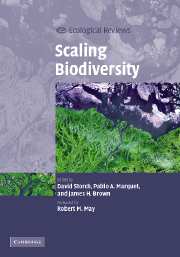Book contents
- Frontmatter
- Contents
- List of contributors
- Foreword by Robert M. May (Lord May of Oxford)
- Preface
- 1 Introduction: scaling biodiversity – what is the problem?
- PART I Spatial scaling of species richness and distribution
- PART II Alternative measures of biodiversity: taxonomy, phylogeny, and turnover
- 7 Biodiversity scaling relationships: are microorganisms fundamentally different?
- 8 The importance of phylogenetic structure in biodiversity studies
- 9 On the quantification of local variation in biodiversity scaling using wavelets
- 10 The scaling of spatial turnover: pruning the thicket
- PART III Scaling of biological diversity with energy and the latitudinal biodiversity gradient
- PART IV Processes, perspectives, and syntheses
- Index
- Plate section
- References
10 - The scaling of spatial turnover: pruning the thicket
Published online by Cambridge University Press: 05 August 2012
- Frontmatter
- Contents
- List of contributors
- Foreword by Robert M. May (Lord May of Oxford)
- Preface
- 1 Introduction: scaling biodiversity – what is the problem?
- PART I Spatial scaling of species richness and distribution
- PART II Alternative measures of biodiversity: taxonomy, phylogeny, and turnover
- 7 Biodiversity scaling relationships: are microorganisms fundamentally different?
- 8 The importance of phylogenetic structure in biodiversity studies
- 9 On the quantification of local variation in biodiversity scaling using wavelets
- 10 The scaling of spatial turnover: pruning the thicket
- PART III Scaling of biological diversity with energy and the latitudinal biodiversity gradient
- PART IV Processes, perspectives, and syntheses
- Index
- Plate section
- References
Summary
Introduction
The level and pattern of spatial variation in the similarity (or dissimilarity) in composition of local or regional species assemblages is striking. Some pairs of areas have similar levels of richness but share no individual species in common (e.g. some local assemblages existing under similar environmental conditions on different continents), others have markedly different levels of richness but all the species in the less speciose area also occur in the other (e.g. some habitat patch or island systems), and there are all shades of patterns in between.
Such spatial turnover in species identities, or beta diversity (we will use the two terms interchangeably), lies at the heart of many important ecological issues and phenomena, including the magnitude of regional and global diversities, the determinants of those diversities, likely biotic responses to climate change, and the design of protected area networks (Cody, 1986; Magurran, 1988, 2004; Harrison, Ross & Lawton, 1992; Harrison, 1993; Oliver, Beattie & York, 1998; Groves, 2003; Koleff, Gaston & Lennon, 2003a). And yet, historically, spatial turnover has received notably less attention than has spatial variation in raw species numbers (i.e. species richness).
- Type
- Chapter
- Information
- Scaling Biodiversity , pp. 181 - 222Publisher: Cambridge University PressPrint publication year: 2007
References
- 31
- Cited by

